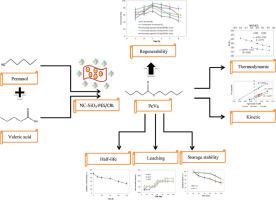Molecular Catalysis ( IF 4.6 ) Pub Date : 2021-09-08 , DOI: 10.1016/j.mcat.2021.111852 Nursyafiqah Elias 1, 2 , Roswanira Abdul Wahab 1, 2 , Sheela Chandren 1, 2 , Woei Jye Lau 3

|
The present study reports the groundwork for preparing a greener catalyst, Candida rugosa lipase (CRL), supported on biomass-based nanocellulose-silica-reinforced polyethersulfone membrane (NC-SiO2-PES) and proved its stability in synthesizing pentyl valerate. The NC-SiO2-PES/CRL-catalyzed synthesis of the ester exhibited a ping-pong bi-bi mechanism, with a high Vmax value and low Km value over the free CRL, confirming the former's greater substrate affinity. The kinetics data demonstrated that the NC-SiO2-PES/CRL was catalytically more efficient than its free counterpart. The lower Michaelis-Menten constant of NC-SiO2-PES/CRL for pentanol (Km,B = 43.53 mM) than valeric acid (Km,A = 82.03 mM) indicates that pentanol was favored over the latter. Pertinently, the higher thermal deactivation values of NC-SiO2-PES/CRL indicated that the NC-SiO2-PES membrane successfully enhanced CRL thermal stability, and the process followed first-order kinetics (R2 > 0.95). The NC-SiO2-PES/CRL has a slightly greater activation energy (Ea) and activation energy for thermal denaturation (Ed) over the free CRL. NC-SiO2-PES/CRL also exhibited extended operational stability, with a robust half-life of ∼150 h and the absence of leached protein after 60 min of agitation. The NC-SiO2-PES/CRL's ability to be regenerated chemically and ultrasonically and reused without significant loss in enzyme activity denotes its potential cost-saving to produce pentyl valerate.
中文翻译:

纳米纤维素-二氧化硅增强的聚醚砜膜支持的皱纹念珠菌脂肪酶合成戊酸戊酯的性能:动力学、热力学和可再生性研究
本研究报告了制备更绿色催化剂——Candida rugosa 脂肪酶(CRL)的基础,该催化剂负载在基于生物质的纳米纤维素-二氧化硅增强聚醚砜膜(NC-SiO 2 -PES)上,并证明了其在合成戊酸戊酯中的稳定性。NC-SiO 2 -PES/CRL 催化合成的酯表现出乒乓bi-bi 机制,与游离CRL 相比具有较高的V max值和较低的K m值,证实前者具有更大的底物亲和力。动力学数据表明,NC-SiO 2 -PES/CRL 的催化效率高于其游离对应物。NC-SiO 2 -PES/CRL 对于戊醇 (K m, B = 43.53 mM) 比戊酸 (K m, A = 82.03 mM) 表明戊醇优于后者。相应地,NC-SiO 2 -PES/CRL较高的热失活值表明NC-SiO 2 -PES 膜成功地增强了CRL 的热稳定性,并且该过程遵循一级动力学(R 2 > 0.95)。NC-SiO 2 -PES/CRL 具有比游离 CRL 稍大的活化能 (E a ) 和热变性活化能 (E d )。NC-SiO 2 -PES/CRL 还表现出扩展的操作稳定性,具有约 150 小时的稳健半衰期,并且在搅拌 60 分钟后不存在浸出的蛋白质。NC-SiO2 -PES/CRL 能够通过化学和超声波再生和重复使用而不会显着降低酶活性,这表明它可以节省生产戊酸戊酯的成本。



























 京公网安备 11010802027423号
京公网安备 11010802027423号